How To Learn Scales On Piano
Piano scales are an important part of developing your playing skills and understanding the building blocks of music. They help enormously to understand key signatures.
If you take ever wondered why pianists play them, how they work and what the benefits are so you are in the right place. With a unproblematic formula you volition learn to play major, minor and dejection scales. If you incorporate a few minutes of learning and practicing scales into your daily schedule, you'll presently see the advantages of making time for scales.
What are piano scales?
Musical Scales are unremarkably misunderstood, only they are actually quite simple. Scales are a group of notes, in alphabetical society, that are a specific distance apart from each other. Nosotros think of scales as having two parts, a root and a quality.
In the F major calibration, the Root is "F", which is the note that we begin counting our scale from, it is our first letter in our musical alphabet in this scale.
The quality of the F major scale is major. This ways our blueprint of whole steps and half steps will be the exact aforementioned as every other "Major Calibration". So, even though an F Major Scale and an A Major Calibration have different Root Notes, their scale "Qualities" are the same. This is why nosotros are going to teach you the piano scales for beginners. Starting with the pattern for all major scales, and so you lot will learn all of the scales simultaneously, instead of just one.
Whole-steps and half-steps – the building blocks of scales
Before learning how to build these scales hither is a reminder of Whole Steps and Half Steps.
- Half Step: This is the smallest altitude on the piano. Information technology occurs between any key and it's firsthand nearest fundamental. This does not hateful from white to black, or from white-to-white. It means the immediate nearest annotation, above or below.
- Whole Stride: A whole step is ii one-half steps in either direction. You can recall this considering 2 halves make a whole, two half-steps make a whole-pace.
Why do piano scales?
Practicing scales is the key to knowledge of the pianoforte. Not only practise they increase your awareness of primal signatures, only they too lead to finger endurance and musculus memory. Your speed playing scales volition plough into conviction and ease in pieces of music y'all play. At that place are so many productive ways you can practice scales and arpeggios that will make playing them fun rather than a job! In addition to practicing in the circle of fifths , here are some smashing ideas to contain into your daily practise:
half-dozen tips for practicing your scales
There are then many productive means you can practice scales that will make playing them fun rather than a chore! Hither are some great ideas to incorporate into your daily practice:
- Try playing in different octaves with both hands.
- Use an online metronome . This is a very well tried method of getting even, speedy scales that nonetheless stays pop, because information technology works!
- Try a different cardinal every week. This volition help you acquire your keys and key signatures really well.
- Go along a exercise diary to record all your practice sessions. This way you can track your progress really well and meet what does and doesn't work for you.
- Use unlike rhythms. Using a dotted note rhythm with a long note first is always a good start. Playingin different speeds and using dissimilar rhythms is great strengthening exercise for your fingers . Information technology's a encephalon work-out as well, while you lot're learning new scales.
- Practise more than than one octave at a time. Once you lot've got it flowing and very even, you want to advance to two octaves, then 3 and eventually, four.
💡 Click here to jump downward to the piano scales generator
Different types of piano scales
The nigh mutual types of scale are major scales, pocket-size scales and the blues scale. Allow'south look at each type. Call up what was written in the introduction. Scales accept 2 parts, a Root and a Quality. Here we will focus on learning the different Qualities of Scales. Get-go we expect at Major.
Understanding the major scales
Major scales are normally associated with upbeat and optimistic music. To build a major scale y'all follow this pattern of semitones and tones. Major Scales are the most common in all music, and they are the starting place for about every pianist.
Root – Whole-Step – Whole-Stride – Half-Step – Whole-Stride – Whole-Footstep – Whole-Stride – Half-Step
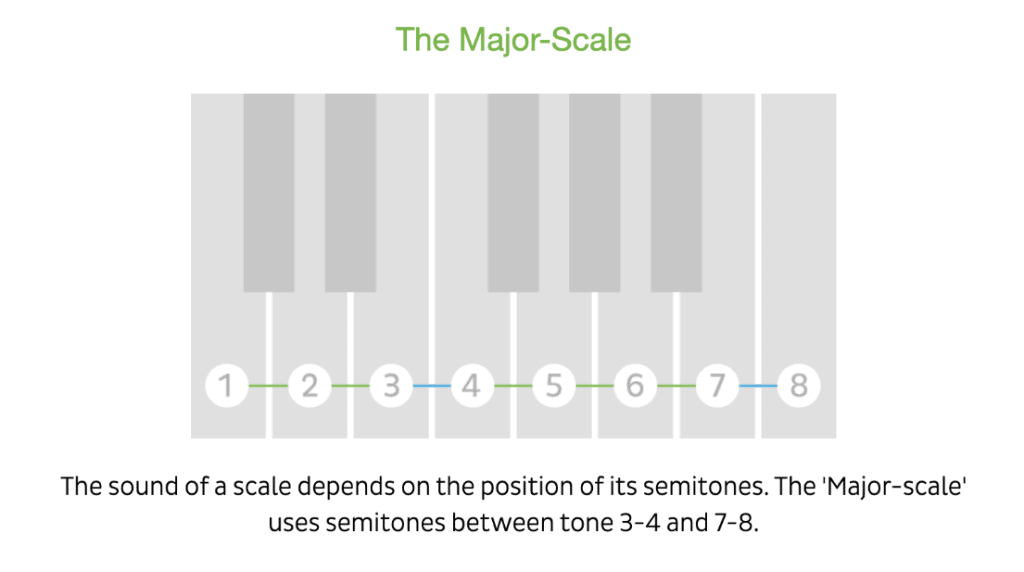
Understanding the minor scales
There are three principal different types of minor scales: natural, harmonic and melodic.
While major scales audio quite happy, minor scales sound mysterious, sad, or exotic. They are often used to express more complex emotions. Pay attention to how the scale degrees are different than major. The construction of a natural pocket-size scale looks similar this:
The first minor scale: the natural minor calibration
A, B, C, D, East, F, G, A
Tonic – Tone – Semitone – Tone – Tone – Semitone – Tone – Tone
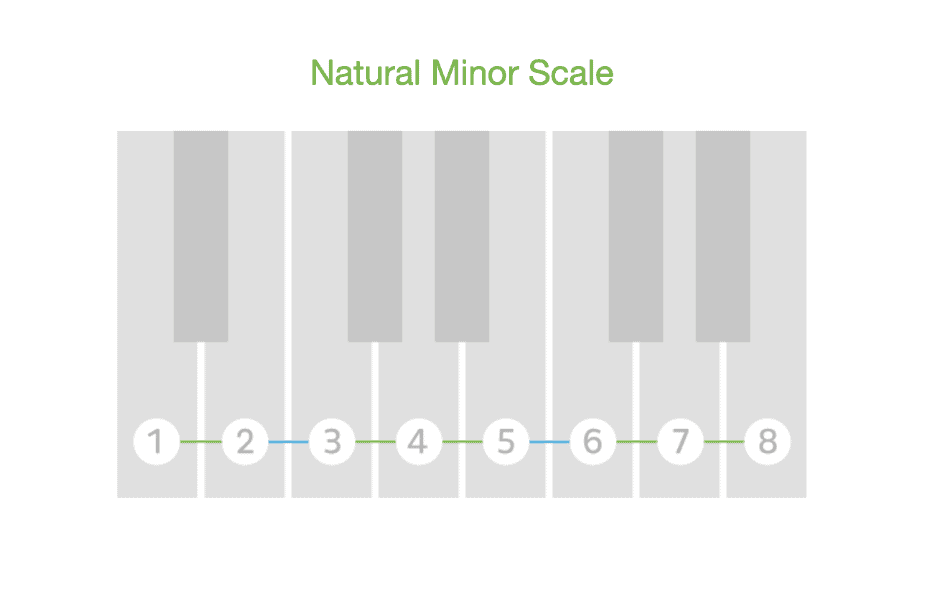
This calibration uses the same fingering design as the C-major calibration higher up. "Mad World" by Tears For Fears introduces the A small calibration. Acquire the A-small scale in the related Skoove lesson. Skoove will give you guidance and instant feedback on your playing.
The natural pocket-sized scale is also called 'aeolian' scale. The semitones are between annotation 2-three and 5-6.
The second pocket-sized calibration: the harmonic small-scale scale
The harmonic scale is notable for its raised 7th note which does not appear in the key signature. This raised 7th means there is an interval of three semitones betwixt the 6th and seventh note. This is the almost commonly used minor scale in western music. The construction looks similar this:
Tonic – Tone – Semitone -Tone – Tone – Semitone – 3 semitones – Semitone
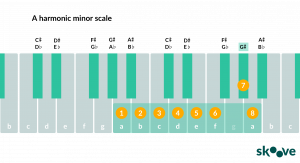
The third pocket-size scale: the melodic pocket-sized scale
To create a "melodic small-scale" scale, you all the same flatten the tertiary note of the scale, but you raise both the 6th and seventh notes by a one-half-step going upwardly. Coming down, you flatten both the sixth and 7th calibration-degrees, so the scale is very dissimilar going up from coming down.
- Ascending: Tonic – Tone – Semitone – Tone – Tone – Tone – Tone – Semitone
- Descending: Tonic – Tone – Tone – Semitone – Tone – Tone – Semitone – Tone
This is an avant-garde Scale Design, so don't worry well-nigh skipping it and coming dorsum to it. Information technology sounds like a major and minor scales been played at the aforementioned time.
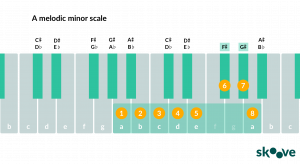
Practicing reverse motion in scales
Contrary – meaning opposite – and motion – meaning movement. These are scales that move in reverse directions and are fun to play. Certain keys are really challenging to play in this style, simply give you the side by side level of skill if you lot do them !
C major is the easiest ane to play. To play a contrary motion scale in C major, start with both your thumbs on middle C. Your left manus is going to perform a descending scale while your right mitt is going to perform an ascending scale, at the aforementioned time. The play a joke on to this is that it is actually quite piece of cake, when you realize your easily are using the exact same fingering, only moving autonomously and then toward each other.
Simply five notes: the major pentatonic scale
Some other very ordinarily used scale in blues, jazz and even popular music is the Pentatonic scale. It's a shorter scale, consisting of 6 notes, (if you double the root note at the top), and it has a major and minor variation. The major pentatonic is structured like this:
Root – Whole-Step – Whole-Step – iii Half-Steps – Whole-Step – 3 One-half-Steps
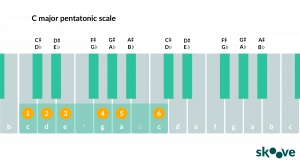
Play a minor blues with the minor pentatonic scale
The minor pentatonic is structured like this:
Root – 3 Half-Steps – Whole-Pace – Whole-Pace – 3 Half-Steps – Whole-Steps
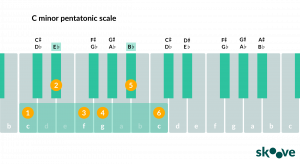
How to play the whole tone calibration
This blazon of scale sounds rather "ethereal" and romantic. Claude Debussy used this scale frequently in his music. Listen to "La Mer" arranged for 2 pianos to go the sense of wonder that this scale conjures.
The construction is just as its name implies:
Root – Whole-Step – Whole-Pace – Whole-Pace – Whole-Stride – Whole-Step
Piano scales generator
This pianoforte scales generator from Pianoworld is handy tool to learn scales. Information technology is interactive and easy to utilize.
If you are reading this from a mobile device, rotate it to display the tool in full width.
1. Click on "Scale"
2. Choose the "Root" of the scale
ii. Choose the "Blazon" (major, minor, etc.)
three. Click "Display"
* You tin can do the aforementioned with scales.
** You tin invert chords and scales
Summing up the scales
Exploring new and interesting scale patterns tin can lead to some very interesting results. Maybe you will try a new calibration and retrieve of sadness, or sunlight, or outer infinite, or something crazy similar the chromatic scale ! You can fifty-fifty try combining your new scales with basic piano chords
There is a reason why composers and pianists of all skill levels practice scales, because they are the key to learning nigh new major keys and new ways to express yourself. The best way to acquire to express yourself with the piano is by taking online pianoforte lessons , and using the new Piano App Skoove's Free Trial!
Author of this weblog post:

Source: https://www.skoove.com/blog/piano-scales/
Posted by: brownpiten2002.blogspot.com


0 Response to "How To Learn Scales On Piano"
Post a Comment